![]()
![]()
![]()
Use LEFT and RIGHT arrow keys to navigate between flashcards;
Use UP and DOWN arrow keys to flip the card;
H to show hint;
A reads text to speech;
138 Cards in this Set
- Front
- Back
|
What type of joint is SC joint? |
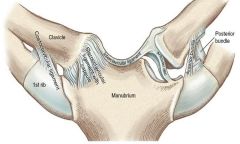
Saddle Synovial with INTRA-ARTICULAR DISC |
|
|
When does SC joint move? When is SC joint injured? |
ED -moves into Elevation and Depression during shoulder ELEVATION/DEPRESSION; -injured AFTER the AC joint and CLAVICLE *Think of this in alphabetical order AC joint, clavicle, then SC joint are injured |
|
|
What type of joint is the AC joint? |
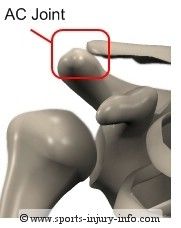
Plane Synovial |
|
|
What ligaments are associated with the AC joint |
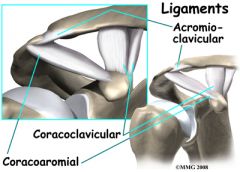
1) Coracoclavicular ligament (Trapezoid [L] and Conoid [M])
2) Acromioclavicular ligament |
|
|
What is the function of the coracoclavicular ligament |
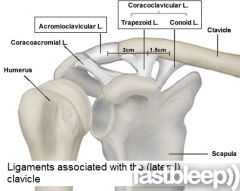
1) Trapezoid (lateral) and Conoid (medial) portions: STABILIZE AC joint and PREVENT UPWARD DISPLACEMENT of HH
2) PREVENT SEPARATION of scapula from clavicle |
|
|
Where is the coracoclavicular ligament positioned relative to other structures? |
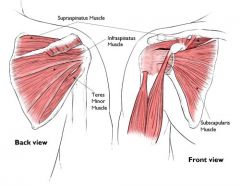
Covers the Supraspinatus can be involved in impingement syndrome |
|
|
When is the AC joint injured? |
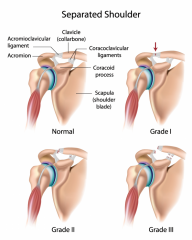
during SHOULDER SEPARATION which leads to injury to ligaments of AC joint and unstable AC joint causing pain and dysfuncition of shoulder joint |
|
|
What type of joint is the glenohumeral joint? |
multi-axial ball and socket (HH and glenoid cavity of scapula |
|
|
What stabilizes the GH joint? |
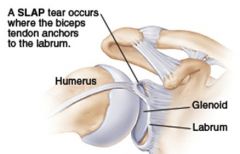
mobility > stability but stabilized by A and P JOINT CAPSULE, glenoid LABRUM, and long head of BICEPS mm (continuous with the labrum) |
|
|
What is the glenoid labrum |
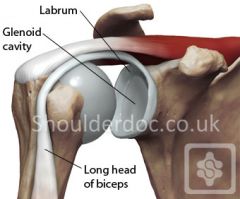
FIBRO-CARTILAGINOUS rim that deepens glenoid cavity and stabilizes GH joint -long head of biceps mm is continuous with labrum |
|
|
What is the ligamentous support of the GH joint? |
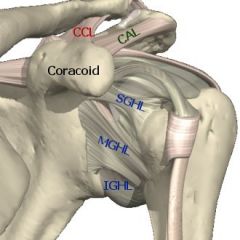
SIM SUPERIOR, INFERIOR, AND MIDDLE GH ligaments = static restraint to excessive anterior translation |
|
|
What are the rotator cuff muscles? |
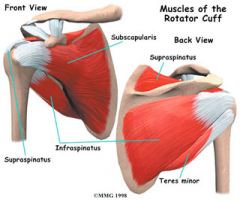
SITS Supraspinatus, Infraspinatus, Teres MINOR, Subscapularis |
|
|
What provides tendon support to GH joint? |

Rotator cuff mms that insert INTO joint capsule -dynamic support provided by muscles contracting and pulling head of humerus down into lower and wider portion of glenoid cavity and allowing full overhead elevation of arm |
|
|
What happens when static support of GH joint is compromised? |
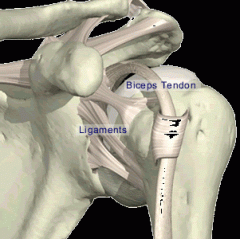
ASYNCHRONOUS firing of the rotator cuff mm may cause subacromial IMPINGEMENT |
|
|
What joints are involved to raise arm overhead? |
4 joints: GASS GH joint AC joint SC joint Scapulothoracic articulation |
|
|
How many degrees of elevation occur at GH joint? How many at Scapulothoracic articulation? |
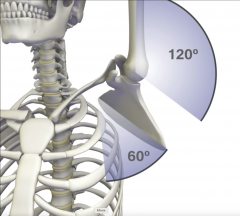
120 deg at GH 60 deg at Scapthoracic GS - 2:1 |
|
|
What motion of clavicle occur during arm elevation? |
ERB Elevates: Elevates, Retracts, Backward rotation -during first 90 deg shoulder abd, clavicle elevates 35-45 deg at SC joint -full scapular UR requires 45-50 deg clavicle posterior/backward rotation (at SC joint) |
|
|
What is the scapulohumeral rhythm? |
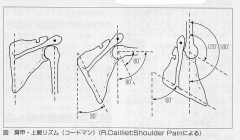
ratio of scapular to humeral motion for elevation is 1:2 (or humeral to scapular ratio 2:1) |
|
|
Describe the muscular stabilizers of the shoulder |
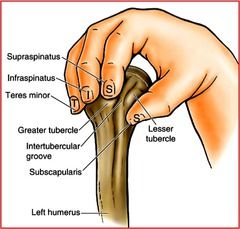
RC work as group to hold HH in glenoid cavity esp during ABD -supraspinatus and coracoacromial arch guard shoulder superiorly -subscapularis stabilizes anteriorly -infraspinatus and teres minor stabilize posteriorly |
|
|
Muscles for UR of scapula during elevation |

URSUL (like URSULA) SERRATUS ANTERIOR and (trapezius) UPPER and LOWER trapezius |
|
|
muscles for downward rot (esp with purposeful shoulder extension i.e. wood chopping) |
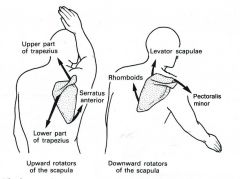
DRRLP Rhomboids, Levator scapula, Pec minor |
|
|
what muscles contribute to protraction? |
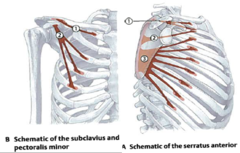
PPS PS: Pec minor and SA |
|
|
what mm contribute to retraction? |
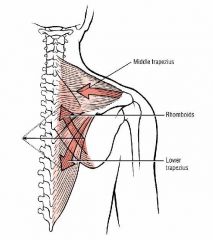
ReTraction-RT RT: Rhomboids and middle & lower Traps |
|
|
what mm contribute to scapular elevation? |

UL Upper traps and Levator scapula |
|
|
what mm contribute to scapular depression? |
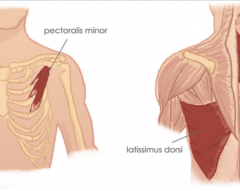
pec minor and lats |
|
|
what bursa is at shoulder? |

SUBACROMIAL bursa which is fused with subdeltoid bursa -palpable by extending humerus -located over bicipital groove under the deltoid mm -separates deltoid from RC -injury=bursitis & shoulder tenderness and restriction of movement |
|
|
Describe circulation into the axilla |
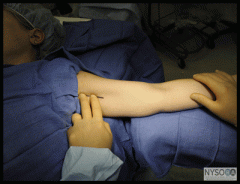
AXILLARY ARTERY is palpable in lateral wall of inferior part of axilla -injury occurs when inferior part pressed against humerus (e.g. resting on crutches) |
|
|
what is crutch palsy? |
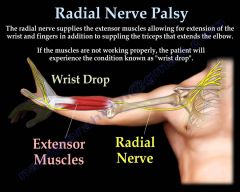
compression of RADIAL nn in axilla due to resting on crutches (also can press the axillary aa against humerus) = WRIST DROP |
|
|
Draw Brachial Plexus |
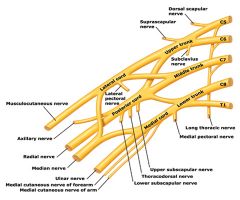
|
|
|
what nerves branch off before trunks form? i.e. off rami |

dorsal scapular long thoracic nn
|
|
|
what does dorsal scapular nn innervate and results of injury to the nerve? |
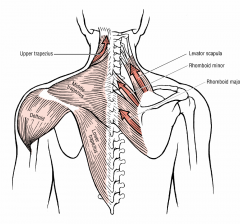
LEVATOR SCAPULA and RHOMBOIDS -injury effects scapular retraction and downward rotation |
|
|
when do the TRUNKS form? |
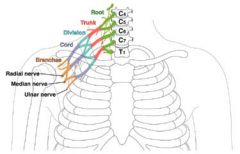
superior, middle, and inf -as they pass over the first rib C8 and T1 pass on either side of the first rib |
|
|
where does the suprascapular nn arise and travel to? |

from superior trunk and passes beneath trapezius through scapular notch to innervate the supraspinatus and infraspinatus |
|
|
what does injury to the suprascapular nerve cause and when does it happen? |
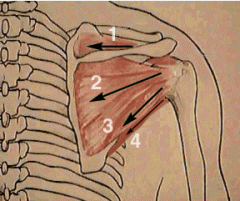
injury to nerve from IMPINGEMENT by the SUPERIOR TRANSVERSE SCAPULAR LIGAMENT causes pain and DECREASED AB and ER of the shoulder |
|
|
where do trunks DIVIDE? |
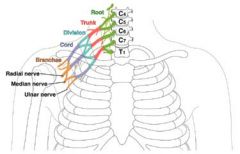
into divisions (3 ant and 3 post) BENEATH THE CLAVICLE |
|
|
where are lateral, posterior and medial CORDS formed? |
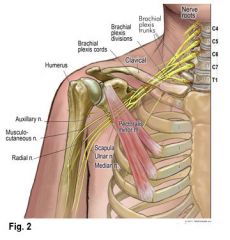
BENEATH PEC MINOR |
|
|
what is the MOI for cord injuries? |
postural dysfunction or traumatic injury due to impingement of the brachial plexus beneath the clavicle or pectoralis minor |
|
|
when do the brachial plexus BRANCHES form? |
as the cords pass under the pectoralis minor |
|
|
what is the most frequent fracture site of the proximal humerus? |
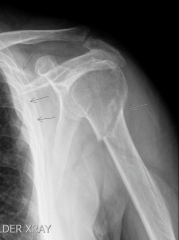
surgical neck (where bone narrows to become the shaft) |
|
|
what brachial branches are injured with fractures of humerus |

URA ulnar radial, axillary *Ura fractured his humerus |
|
|
what type of joint is the ulnohumeral joint |
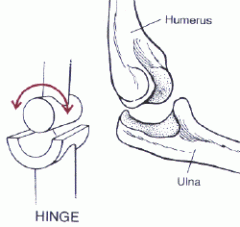
uniaxial HINGE between ulnar trochlear notch and the trochlea of the humerus (anterior/inferior) |
|
|
what ligament is at the ulnohumeral joint? |
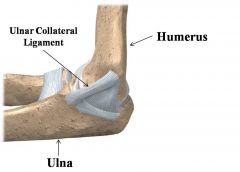
ULNAR COLLATERAL (AKA: LCL) ligament stabilizes joint -carrying angle: -10-15 deg in men -20-25 deg in women with arm at the side |
|
|
What happens with movement at the ulnohumeral joint? |
gaps medially in full extension, laterally in full flexion and glides side to side in supination/pronation *Look at your arm extended and picture the joint to help with this |
|
|
what type of joint is the radiohumeral joint? |
uniaxial hinge between radial head and the capitulum of the humerus |
|
|
What ligament is associated with the radiohumeral joint? |
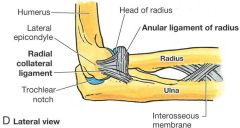
RADIAL COLLATERAL ligament: provides lateral stablity injury may interfere with elbow flexion and extension |
|
|
what type of joint is the superior radioulnar joint? |
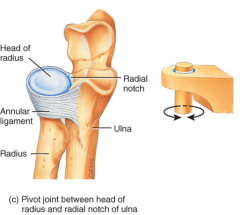
uniaxial pivot joint between the radial proximal head and the medial portion of the proximal ulna |
|
|
what motion occurs at superior radioulnar joint? |
spherical radial head allows ROTATION needed for supination/pronation |
|
|
what ligament is at the superior radioulnar joint? |
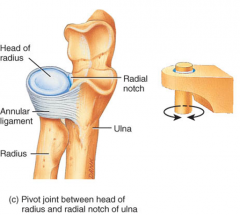
ANNULAR ligament provides stability by surrounding the radial head |
|
|
what can injury of the superior radioulnar joint cause? |
limitation in ability to control the position of the hand |
|
|
What makes up the middle radioulnar joint? |
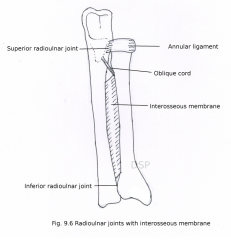
interosseous membrane and the oblique cord -interosseous membrane stabilizes the elbow during pushing movements -oblique cord resists distal displacement of the radius during pulling movements |
|
|
How many joints make up the elbow? |
3 joints: 1. ulnohumeral joint 2. radiohumeral joint 3. radioulnar joints
|
|
|
How many groups of muscles control movements at the elbow? How many total muscles? |
-4 groups that synergistically control elbow flexion/ext and supination/pronation -8 muscles exert force to move the elbow |
|
|
What muscles contribute to elbow flexion? |
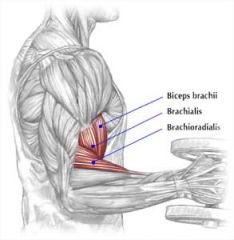
B3: brachialis, biceps brachii, & brachioradialis
(flexor carpi ulnaris and pronator teres may contribute) |
|
|
What is the main elbow flexor? |
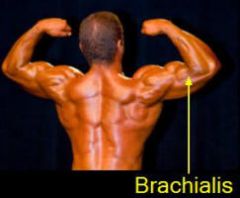
**BRACHIALIS** (NOT biceps brachii) |
|
|
In what elbow/forearm positions does the brachialis flex the elbow? |
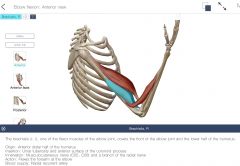
acts in shoulder flexion or extension & forearm supination or pronation |
|
|
In what elbow/forearm positions does the biceps brachii act on the elbow? |
when in supination, flexes the forearm or flexes the forearm when lifting >2 lb |
|
|
What movement does brachioradialis cause? |
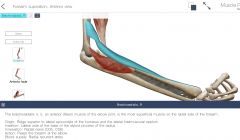
flexes the elbow and STABILIZES supination and pronation during strong resistance |
|
|
Besides the main elbow flexors, what other muscles may contribute to elbow flexion? |

Flexor carpi ulnaris Pronator teres |
|
|
What are the main elbow extension muscles? |
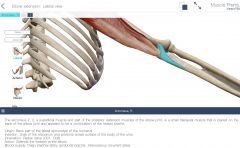
TRICEPS brachii is the main extensor with ANCONEUS assisting and providing STABILITY during supination and pronation |
|
|
Besides triceps and anconeus, what other muscles may contribute to elbow extension? |
PEC MAJOR and ANT DELT facilitate elbow extension in closed chain movements such as push-ups or pushing heavy objects (Think of doing push ups) |
|
|
What muscles produce supination? |
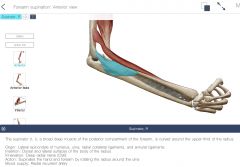
supinator and biceps brachii |
|
|
when does the supinator act? |
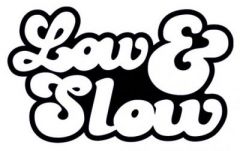
with LOW loads and with SLOW movements |
|
|
when does the biceps brachii cause supination? |
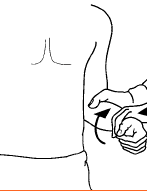
when elbow is flexed to 90 deg |
|
|
what muscles produce pronation? |
pronator teres, pronator quadratus, and FLEXOR CARPI RADIALIS |
|
|
when is the pronator quadratus active for pronation? |
during low loads (similar to the supinator) |
|
|
Describe coordination between muscle antagonist during the action of pulling objects |
elbow flexion by biceps brachii triceps aids shoulder extension and controls elbow flexion |
|
|
Describe coordination between muscle antagonist during the action of pushing an object away from body |
triceps extends elbow biceps controls extension and helps with shoulder flexion |
|
|
Describe coordination between muscle antagonist during the action of turning door knobs or screwdrivers clockwise |
biceps supinates TRICEPS counters flexion action |
|
|
Describe coordination between muscle antagonist during the action of using a fork |
biceps supinates and flexes elbow to bring fork to mouth biceps contracts eccentrically to control putting down fork |
|
|
what bursae are at the elbow |
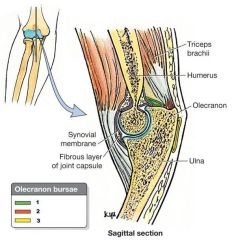
SUBCUTANEOUS and SUBTENDINOUS bursae
|
|
|
where is the subcutaneous olecranon bursa and how is it injured? |
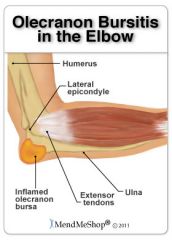
located in tissue over the olecranon injury due to repeated excessive friction (="student's elbow") |
|
|
Where is the subtendinous olecranon bursa located? and when/how is it injured? |
between triceps tendon and the olecranon injury: less common and occurs with excessive friction between triceps tendon and olecranon (e.g. during certain assembly jobs) |
|
|
What artery is associated with the elbow region and where can it be palpated? |

BRACHIAL artery which is a continuation of the axillary artery palpated over anterior region of cubital fossa |
|
|
where is compression of the brachial artery the most effected? |
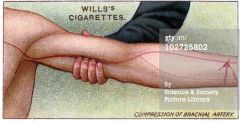
middle of the humerus |
|
|
what injury occurs with occlusion or laceration of the brachial artery |
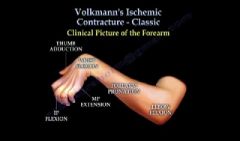
ischemia of the flexor muscles of the forearm causing a Volkmann's ischemic contracture of the involved muscles |
|
|
what is Volkmann's ischemic contracture? |
occurs when there is ISCHEMIA TO FOREARM FLEXORS resulting in contractures of elbow flexion, forearm pronation, wrist flexion, MCP extension, and IP flexion, and thumb adduction |
|
|
where is the head of the ulna and the head of the radius? |
head of radius= at the elbow head of ulna = at wrist |
|
|
Where are the styloid processes of the ulna and radius? |
ulna = distal end on the medial side radial styloid process = distal end on lateral side of the bone -radial styloid process is more distal than ulnar styloid process |
|
|
where is the radius most likely to be fractured? |
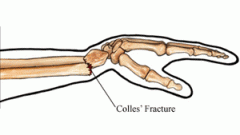
distal radial fracture = Colles' fracture MOI = FOOSH |
|
|
what is a Colles' fracture |
distal radial fracture with MOI commonly fall on outstretched hand (If I had a collie, I would name him Radius) |
|
|
Describe bony anatomy of ulna. |

-Trochlear notch, coronoid process, olecranon process -Humerus has Trochlea, coronoid fossa, olecranon fossa |
|
|
where can you palpate the head of the radius? |
with elbow extended, just distal to lateral epicondyle of humerus |
|
|
where can the radial styloid process be palpated? |
on lateral aspect of wrist |
|
|
where is the ulnar nerve located at the elbow? |
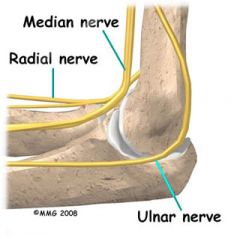
posterior to the medial epicondyle |
|
|
when/where is ulnar nerve most likely to be compressed? |
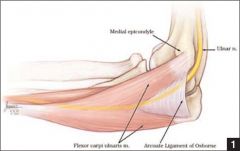
in Osborn's fasica, forming the cubital tunnel, posterior to medial epicondyle |
|
|
Name the carpal bones |
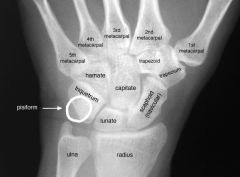
Some lovers try positions that they can't handle (lateral to medial on volar surface)
proximal row: (lat to med) Scaphoid, lunate, triquetrium, pisiform, distal row: trapezium, trapezoid, capitate, hamate |
|
|
what is the flexor retinaculum attached to? |
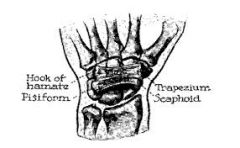
scaphoid and trapezium |
|
|
What is the contents of the carpal tunnel? |
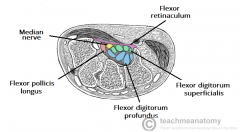
median nn and 9 flexor tendons: (4) FDS, (4) FDP, (1) FPL
superficial: FDS 3 & 4, median nn middle: FDS 2 & 5 Deep: FDP & FPL transverse carpal ligament (aka flexor retinaculum forms roof of carpal tunnel and carpal bones form floor) |
|
|
Which carpal bone is most likely to fracture? |
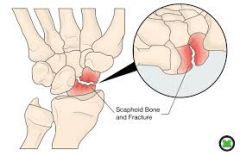
SCAPHOID poor blood supply and can frequently develop avascular necrosis |
|
|
Where are the heads of the metacarpals |
heads are distal |
|
|
how many bones and how many joints are in the wrist, hand, and fingers? |
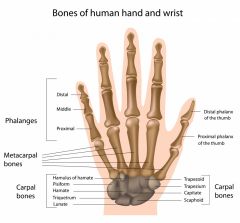
bones: 29 joints: 31 (I think Radius and Ulna are included in this) |
|
|
What is the quantity of movement contributed by the thumb to hand function? |
40% of hand's function is contributed by thumb -(that's almost 1/2)! |
|
|
what are the arches of the hand? |

support the hand for strength and allow prehension 1. longitudinal 2. metacarpalphalangeal transverse (distal transverse arch) 3. carpal transverse (proximal transverse)
|
|
|
what type of injury limits supination/pronation |
damage to mid to distal forearm |
|
|
what type of joint is the radiocarpal and what bones make it up? |
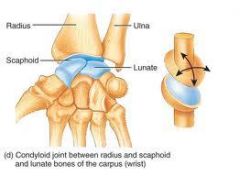
BI-AXIAL ELLIPSOID between radius (concave) and scaphoid and lunate (convex) |
|
|
What stabilizes the radiocarpal joint? |
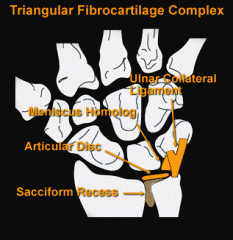
-RADIAL COLLATERAL LIGAMENT on lateral side -triangular shaped disc on the ulna (part of triangular fibrocartilage complex [TFCC] that connects to triquetrium and lunate via ulnar collateral ligament medially) |
|
|
*What is TFCC? |
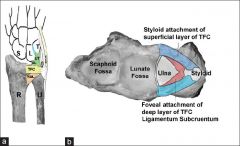
Triangular fibrocartilage complex -articular disk on distal end of ulna connected via two fibrous laminae: 1. dorsal and palmar ligaments attaching to head of ulna and ulnar styloid process 2. ulnar collateral ligament which attaches to triquetrum, hamate, and base of 5th metacarpal and ECU tendon shealth |
|
|
what is the load bearing ratio of radius to ulna |
60:40 |
|
|
What are the motions of the radiocarpal joint? |
5 TOTAL: flexion, extension, radial deviation, ulnar deviation, circumduction |
|
|
What motions occur at intercarpal joint? |
small amount of gliding -dorsal, palmar, and interosseous ligaments stabilize -pisiform sits on triquetrum and does not participate in gliding
|
|
|
*What articulations makes up the midcarpal joint? |

-medially the scaphoid, lunate, triquetrium articulate with hamate and capitate -laterally the scaphoid articulates with the trapezoid and trapezium -stabilized by dorsal and palmar ligaments |
|
|
What is the functional motion of the scaphoid during wrist motions? |
-functions with proximal row of carpals during flexion -functions with distal row during extension (* the only thing that may help with this is when you flex your wrist you can get your fingers to go more proximal than when you extend your wrist where they stay more distal) |
|
|
What dislocation is common in the carpal bones? |
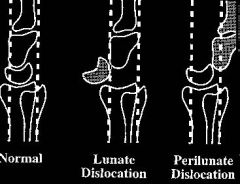
anterior dislocation of the LUNATE resulting in compression of median nn against the flexor retinaculum |
|
|
*What joint does the majority of wrist flexion and wrist extension occur at? |
wrist flexion: mid carpal wrist extension: radiocarpal |
|
|
what wrist position allows effective hand function? |
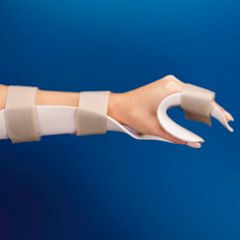
slight extension |
|
|
*What muscle is most active in grasping? |
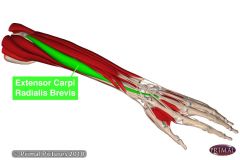
Extensor carpi radialis brevis ECRB which holds wrist in slight extension |
|
|
*what 3 muscles of the wrist/forearm are active in both wrist flexion and extension to provide dynamic stability? |
ECU EPB Abd Pollicis longus |
|
|
*What are the wrist flexors and which is more effective? |
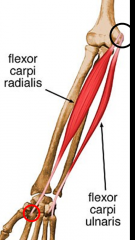
FCR and FCU -FCR is more effective -finger flexors can flex wrist (need to be stabilized during MMT) |
|
|
*what mm produces radial deviation |
ECRB, ECRL, FCR |
|
|
What mm do ulnar deviation? |
ECU, FCU |
|
|
what are the muscles of the anterior forearm |
8 muscles -muscles that pronate forearm and hand: Pronator quadratus and Pronator teres -muscles that flex hand: FCU, FCR and palmaris longus -muscles that flex the digits (FPL, FDP, FDS) FLEXORS: *4-1=3 SUPERFICIAL LAYER 1. Pronator teres 2. FCR 3. Palmaris Longus 4. FCU MIDDLE LAYER 1. FDS DEEP LAYER 1. FDP 2. FPL 3. Pronator Quadratus |
|
|
what are the muscles of posterior forearm |
11 muscles -Muscles that extend the wrist: ECRL, ECRB, ECU -extend medial 4 digits: ED, EI, EDM -extend the 1st digit (thumb): Abductor pollicus longus, EPB, EPL EXTENSORS: 6-6 SUPERFICIAL LAYER: 1. Brachioradialis 2. ECRL 3. ECRB 4. Extensor Digitorum 5. Extensor Digiti Minimi 6. ECU DEEP LAYER: 1. Anconeus 2. Supinator 3. AbPL 4. EPB 5. EPL 6. Extensor Indices
|
|
|
what is the blood supply of the wrist? |
radial artery begins in the cubital fossa and travels medially to radial styloid process -palpation is where radial artery lies on anterior surface of distal radius & lateral to FCR |
|
|
What injury can damage radial artery? |
supracondylar fracture of the elbow can damage radial artery in cubital fossa |
|
|
what type of joints are the 4 medial CMC joints? What ligaments provide stability |
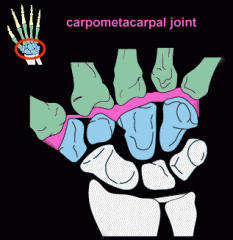
-Plane synovial -Dorsal, palmar, and interosseous ligament support |
|
|
what injuries are common at the CMC joint? |
all CMC joints are susceptible to STRAINS |
|
|
what type of joint is the thumb CMC |
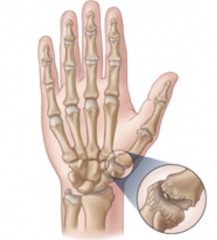
SADDLE with dorsal, palmar, and lateral ligament support |
|
|
Where is the intermetacarpal joints? |
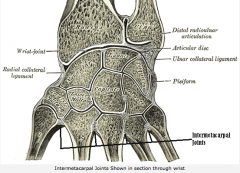
between 2nd through 4th metacarpal bones -plane joints held together by ligaments with small amount of gliding motion |
|
|
What type of joint is the MCP joints? what ligaments provided stability |
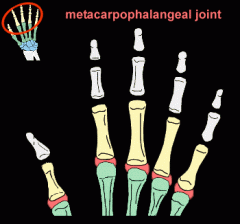
-Condyloid joints -Palmar, transverse and collateral ligaments (tight in flexion) |
|
|
What is unique about the 1st MCP joint? |
It can ROTATE which augments function of 1st CMC joint |
|
|
how many IP joints in each finger? |
2 except the thmb |
|
|
what type of joint are the PIP and DIP? |
uniaxial HINGE: flexion and extension |
|
|
what stabilizes DIP and PIP joints? |
PALMAR and COLLATERAL ligaments and a FIBROUS capsule |
|
|
what happens to IP ligaments in flexion? |
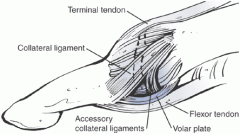
they DO NOT become tight (unlike MCP joint flexion in which the collaterals do become tight) |
|
|
In general what muscle performance characteristic do the hand extrinsic muscles supply vs the intrinsics? |
extrinsics provide POWER intrinsics provide FINE CONTROL |
|
|
How much wrist extension is needed for optimal use of the hand? |
20-30 deg |
|
|
what are the 2 types of functional grasps |
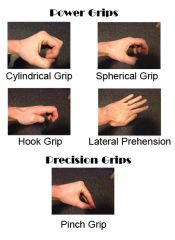
POWER grip PRECISION (prehension) grip |
|
|
What is power grip? |
exerts force on object to hold against hand requires FINGER FLEXION and WRIST EXTENSION with ULNAR DEVIATION |
|
|
what is prehension/precision grip? |
used for accurate function with objects held between tips of fingers |
|
|
what muscles control the thumb? |
4 intrinsic (thenar) and 4 extrinsics (forearm) intrinsic: OP - opponens pollicis FPB - flexor pollicis brevis APB - abductor pollicis brevis adductor pollicis
extrinsic: EPL - extensor pollicis longus EPB - extensor pollicis brevis FPL - flexor pollicis longus APL - abductor pollicis longus |
|
|
what are the muscles of the thenar eminence? |
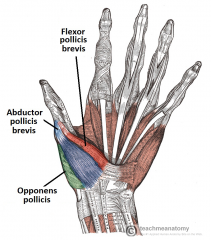
1) Opponens pollicis 2) FPB: Flexor pollicis brevis 3) AbPB Abductor pollicis brevis innervation: (except deep head of FPB) = median nn |
|
|
what are the hypothenar muscles? |

1) flexor digiti minimi 2) abductor digiti minimi 3) opponens digiti minimi 4) palmaris brevis |
|
|
what muscles extend the IPs and MCPs? |
EXTENSOR DIGITORUM (interossei and lumbricals contribute by incr tension on extensor mechanism to allow ED to extend digits) |
|
|
What is the function of the EPL? |
extends IP and MCP of thumb causes CMC retroposition |
|
|
what does the opponens digiti minimi do? |
hollows the palm for cupping the hand (e.g. to drink water from glass or grasp cylindrical object) |
|
|
what does radial nerve damage do to hand/wrist function? |
affects ability to maintain functional wrist position and to release an object |
|
|
what does damage to median nn do to hand/wrist function? |
effects flexion of digits on radial side and precision grip |
|
|
what does damage to ulnar nn do to hand/wrist function? |
flexion of digits on ulnar side and power grip |

